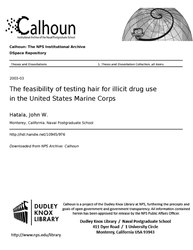File:The feasibility of testing hair for illicit drug use in the United States Marine Corps (IA thefeasibilityof10945976).pdf

Original file (1,275 × 1,650 pixels, file size: 964 KB, MIME type: application/pdf, 92 pages)
Captions
Captions
Summary[edit]
| The feasibility of testing hair for illicit drug use in the United States Marine Corps
( |
||
|---|---|---|
| Author |
Hatala, John W. |
|
| Title |
The feasibility of testing hair for illicit drug use in the United States Marine Corps |
|
| Publisher |
Monterey, California. Naval Postgraduate School |
|
| Description |
The purpose of this thesis was to examine the feasibility of testing hair for illicit drug use in the United States Marines Corps. Specifically, the study determined the hair test's potential for detecting and deterring illicit drug use and abuse among Marines. In addition, the study estimated the potential costs of implementing hair tests and examined fairness concerns with regard to testing hair among ethnically diverse populations. The results indicate that the hair test would be more effective than the urinalysis at detecting a wide variety of illicit drugs, with the exception of marijuana. The increased effectiveness of the hair test is likely to enhance the level of deterrence currently sustained by the Marine Corps' urinalysis program. Costs associated with the implementation of hair test would be offset by the increase in detection of illicit drug use and drug dependence among enlisted recruits and officer candidates pursuing active duty military service. Enhanced deterrence levels among active duty personnel that are a consequence of implementing the hair test would result in additional cost savings. Finally, implementation of the hair test would not result in racial bias, but may amplify the existence of drug preferences among different races. Subjects: Marines; United States; Drug testing; Hair test; Urinalysis; Illicit drug use; Deterrence; Drug detection; Drug policy; Race bias |
|
| Language | English | |
| Publication date | March 2003 | |
| Current location |
IA Collections: navalpostgraduateschoollibrary; fedlink |
|
| Accession number |
thefeasibilityof10945976 |
|
| Source | ||
| Permission (Reusing this file) |
This publication is a work of the U.S. Government as defined in Title 17, United States Code, Section 101. As such, it is in the public domain, and under the provisions of Title 17, United States Code, Section 105, may not be copyrighted. | |
Licensing[edit]
| Public domainPublic domainfalsefalse |
This work is in the public domain in the United States because it is a work prepared by an officer or employee of the United States Government as part of that person’s official duties under the terms of Title 17, Chapter 1, Section 105 of the US Code.
Note: This only applies to original works of the Federal Government and not to the work of any individual U.S. state, territory, commonwealth, county, municipality, or any other subdivision. This template also does not apply to postage stamp designs published by the United States Postal Service since 1978. (See § 313.6(C)(1) of Compendium of U.S. Copyright Office Practices). It also does not apply to certain US coins; see The US Mint Terms of Use.
|
 | |
| This file has been identified as being free of known restrictions under copyright law, including all related and neighboring rights. | ||
https://creativecommons.org/publicdomain/mark/1.0/PDMCreative Commons Public Domain Mark 1.0falsefalse
File history
Click on a date/time to view the file as it appeared at that time.
| Date/Time | Thumbnail | Dimensions | User | Comment | |
|---|---|---|---|---|---|
| current | 06:24, 25 July 2020 |  | 1,275 × 1,650, 92 pages (964 KB) | Fæ (talk | contribs) | FEDLINK - United States Federal Collection thefeasibilityof10945976 (User talk:Fæ/IA books#Fork8) (batch 1993-2020 #29619) |
You cannot overwrite this file.
File usage on Commons
The following page uses this file:
Metadata
This file contains additional information such as Exif metadata which may have been added by the digital camera, scanner, or software program used to create or digitize it. If the file has been modified from its original state, some details such as the timestamp may not fully reflect those of the original file. The timestamp is only as accurate as the clock in the camera, and it may be completely wrong.
| Short title | The feasibility of testing hair for illicit drug use in the United States Marine Corps |
|---|---|
| Author | Hatala, John W. |
| Software used | Hatala, John W. |
| Conversion program | Acrobat Distiller 5.0 (Windows) |
| Encrypted | no |
| Page size | 612 x 792 pts (letter) |
| Version of PDF format | 1.4 |

